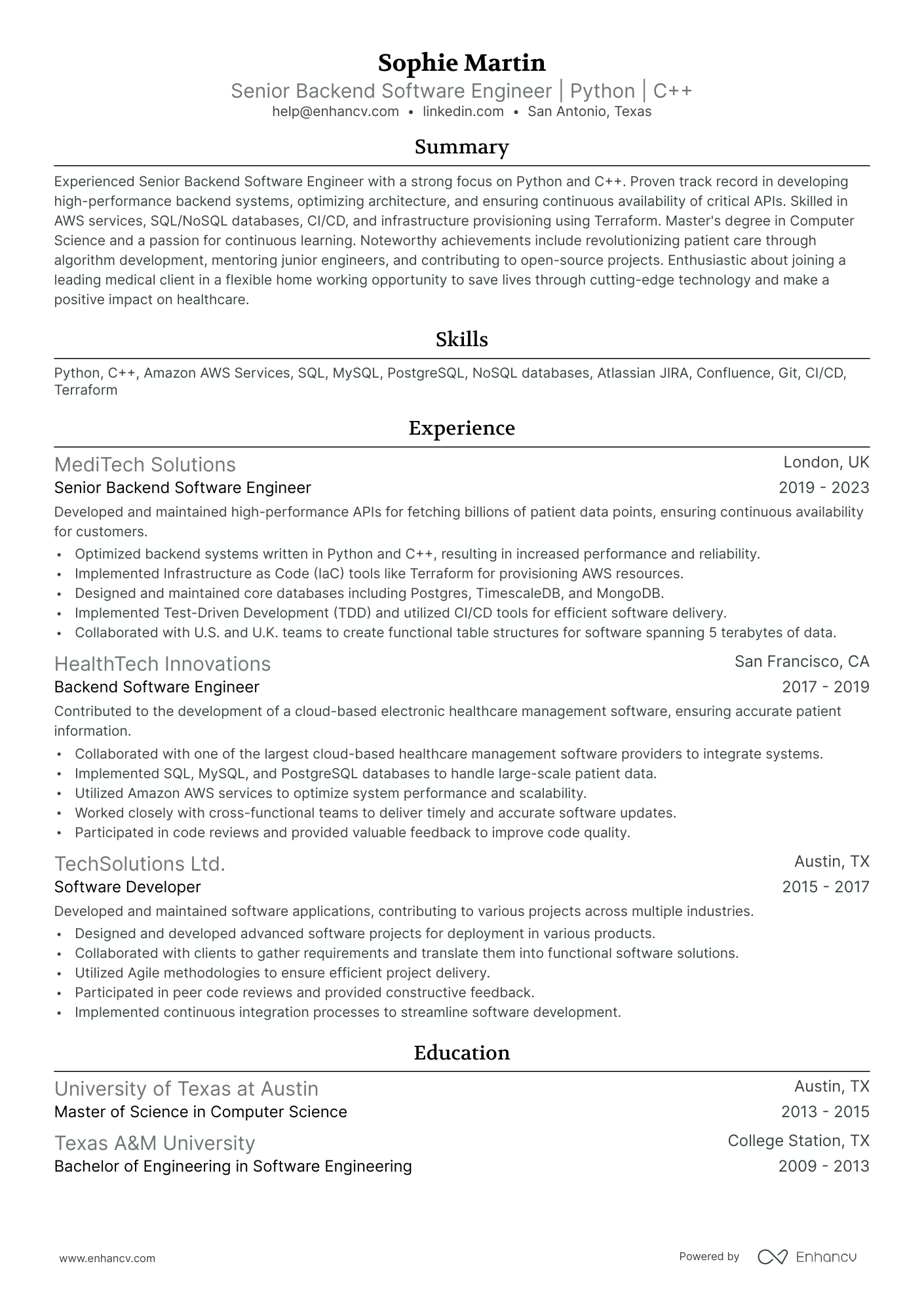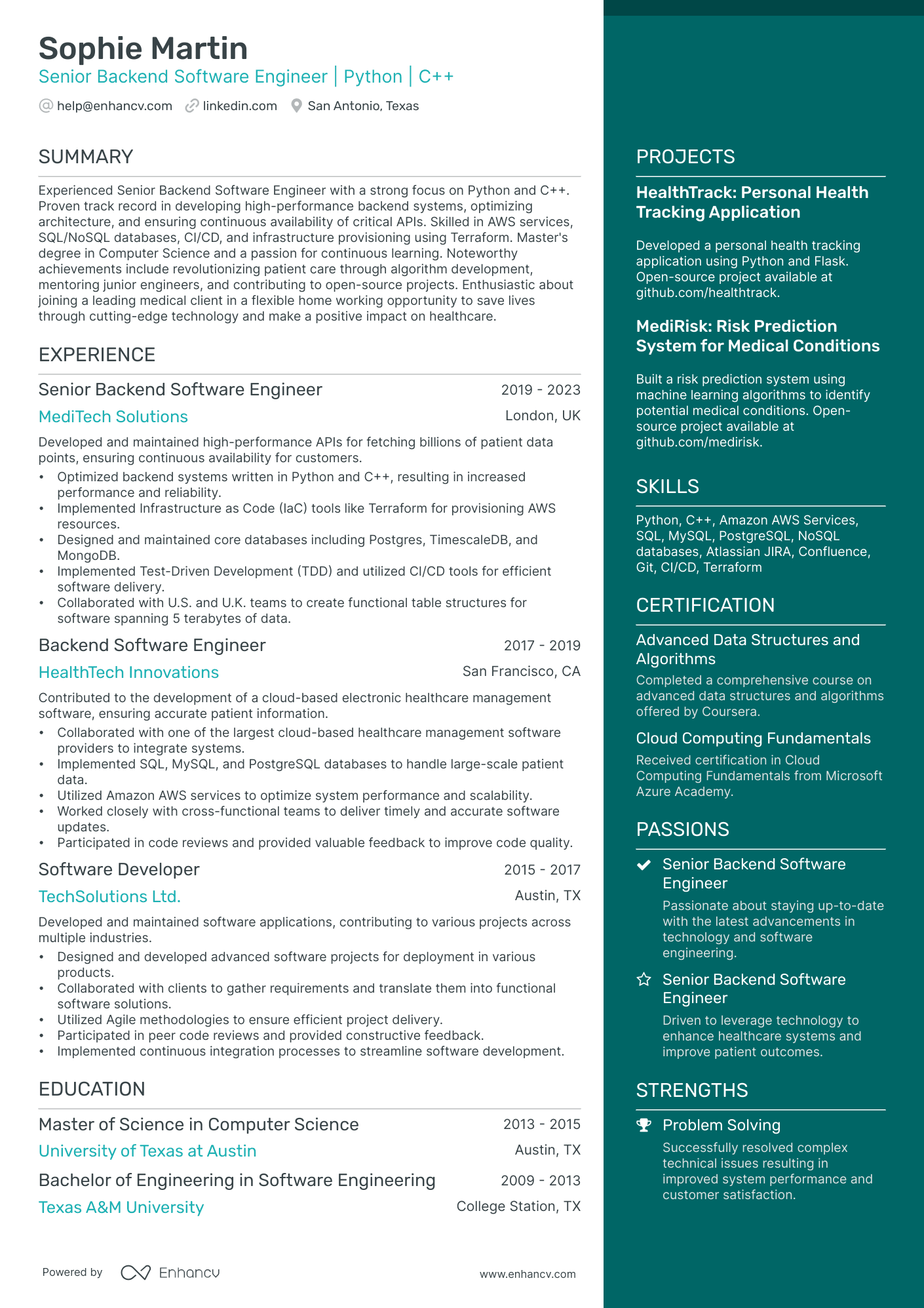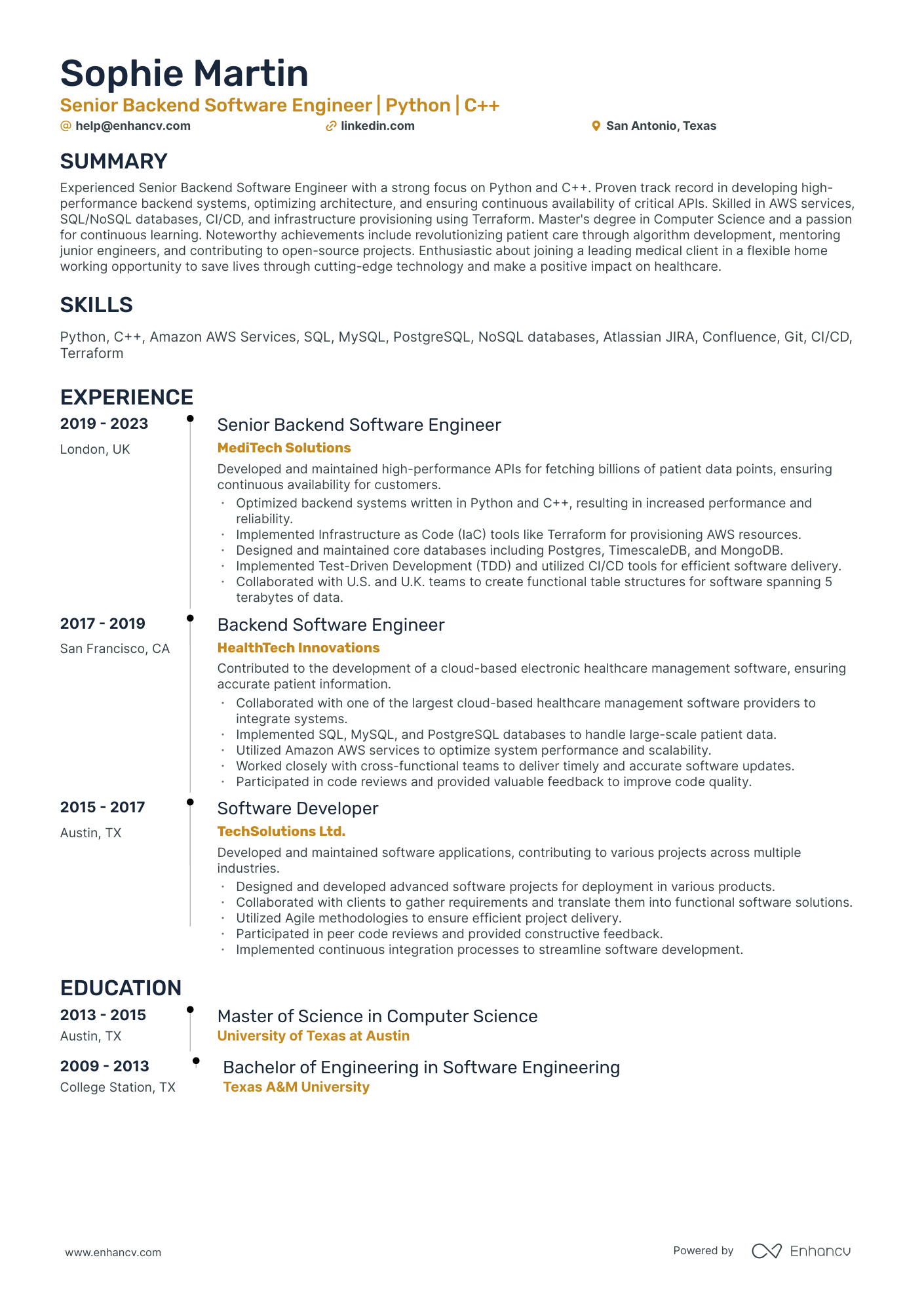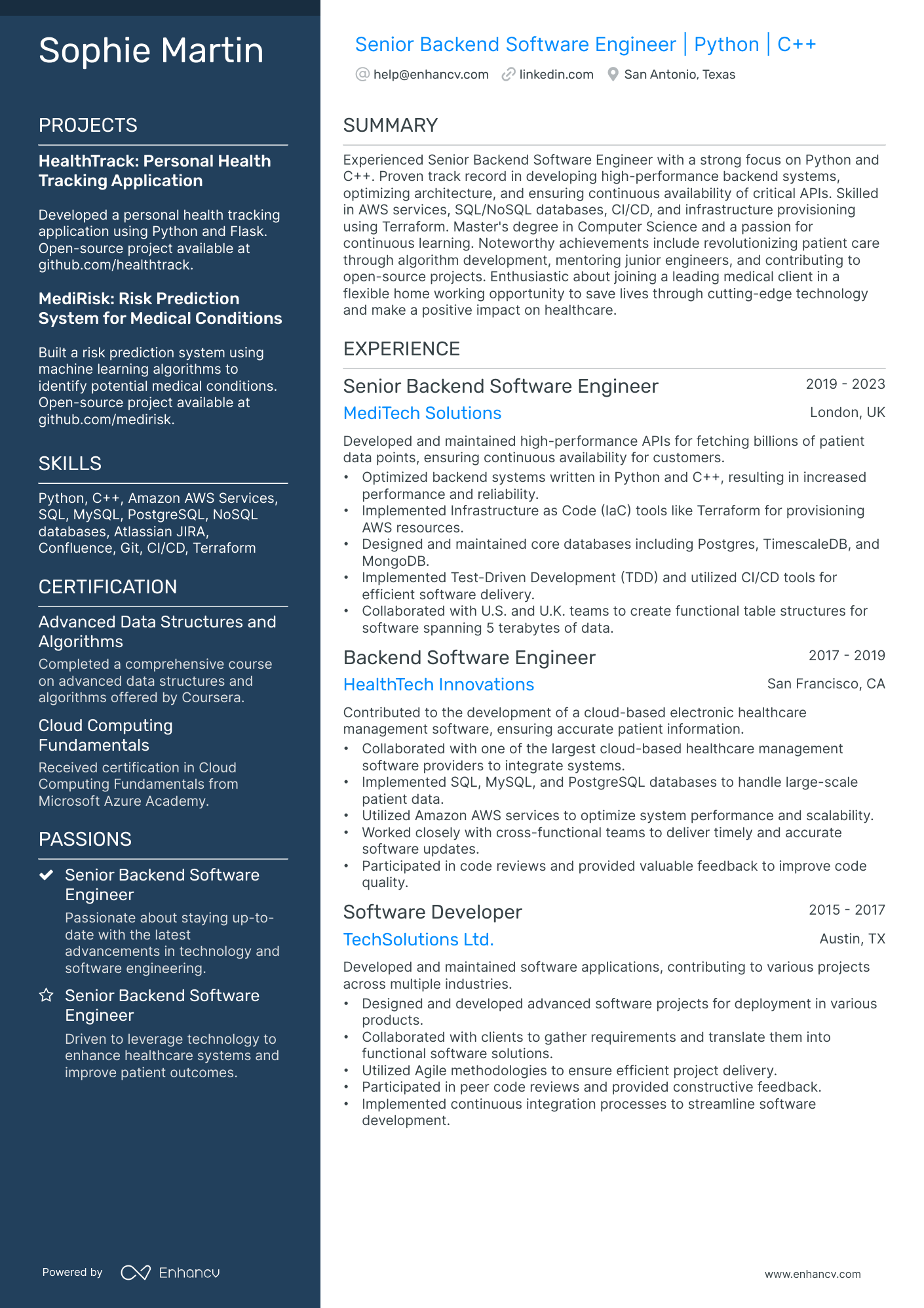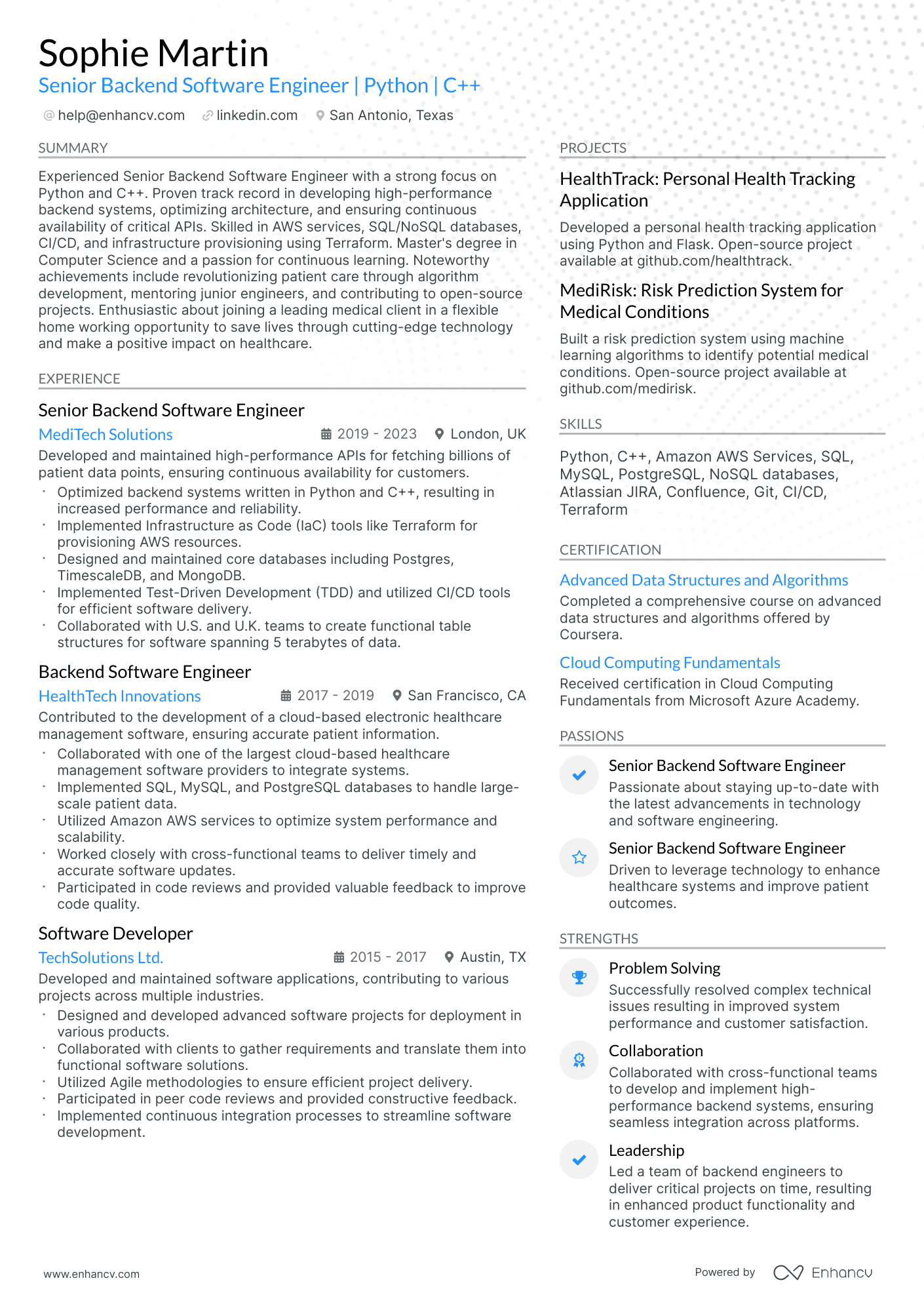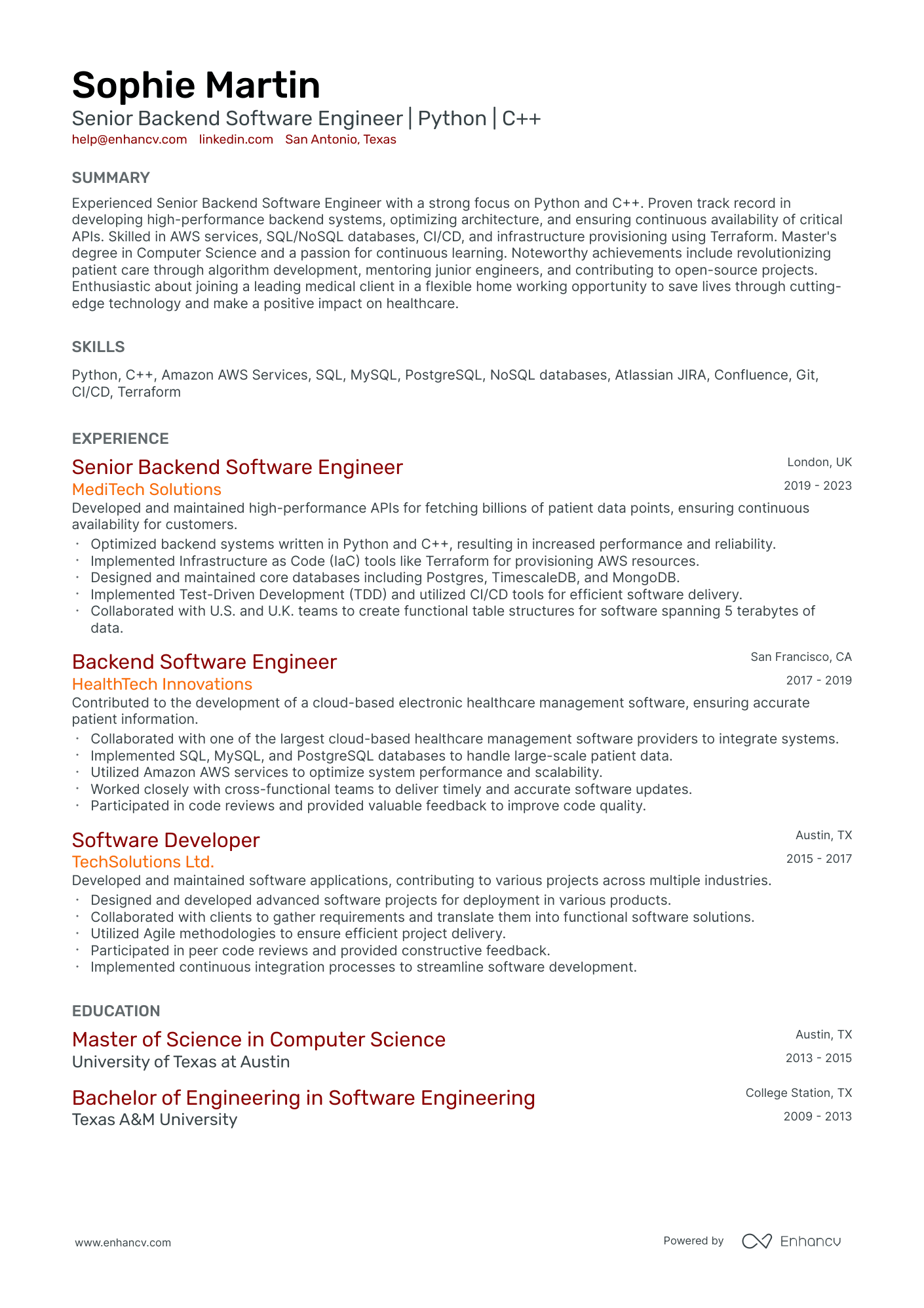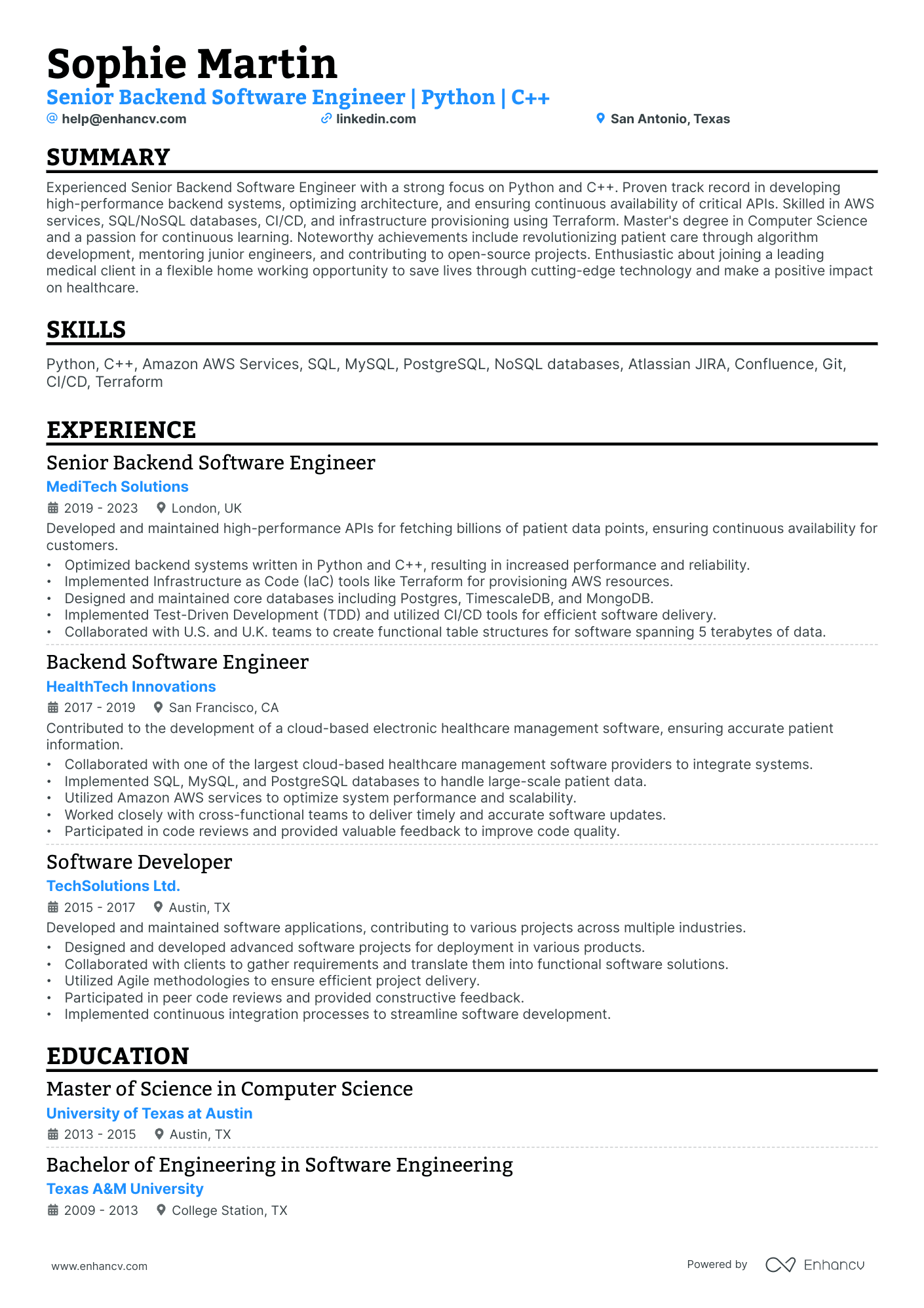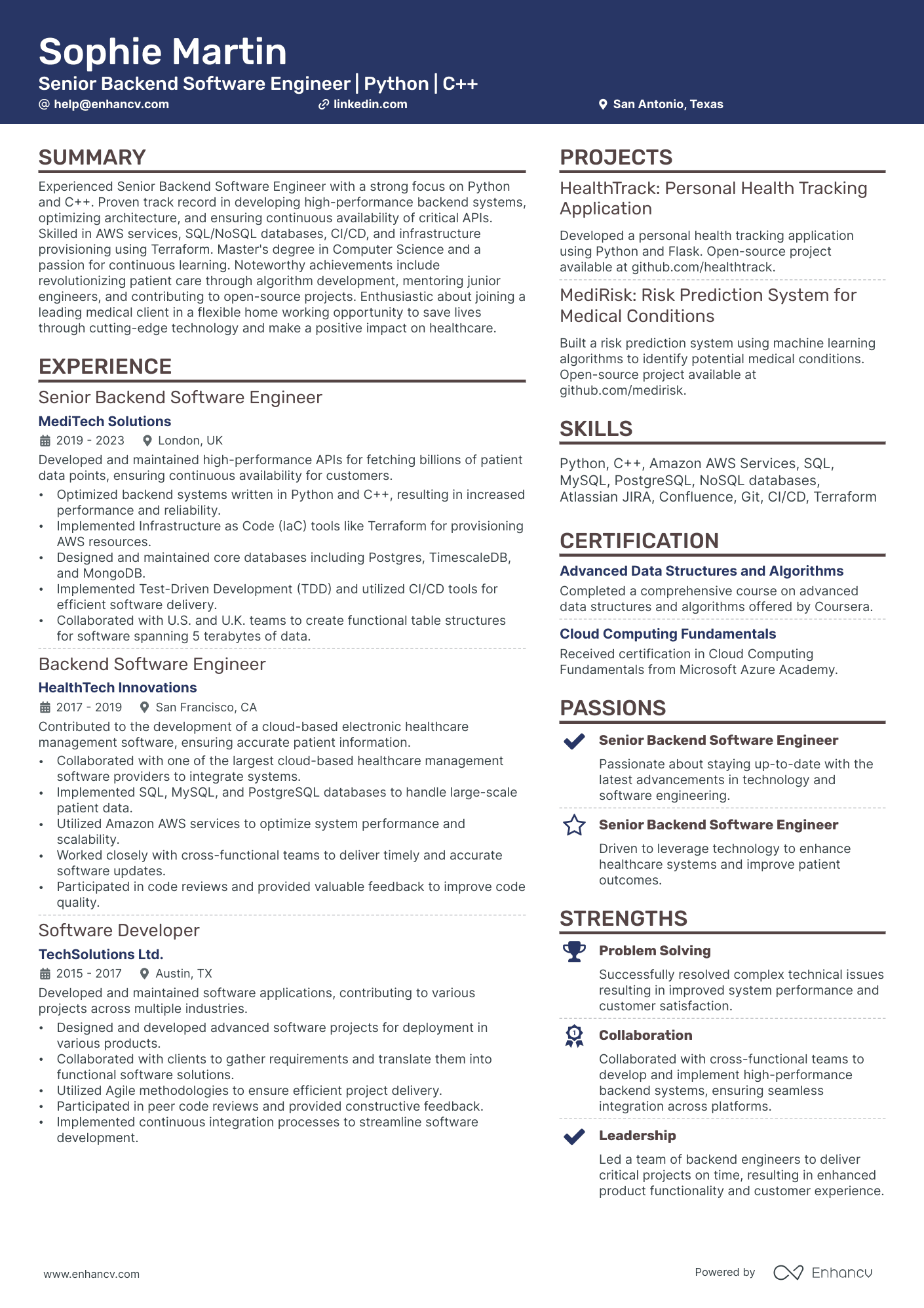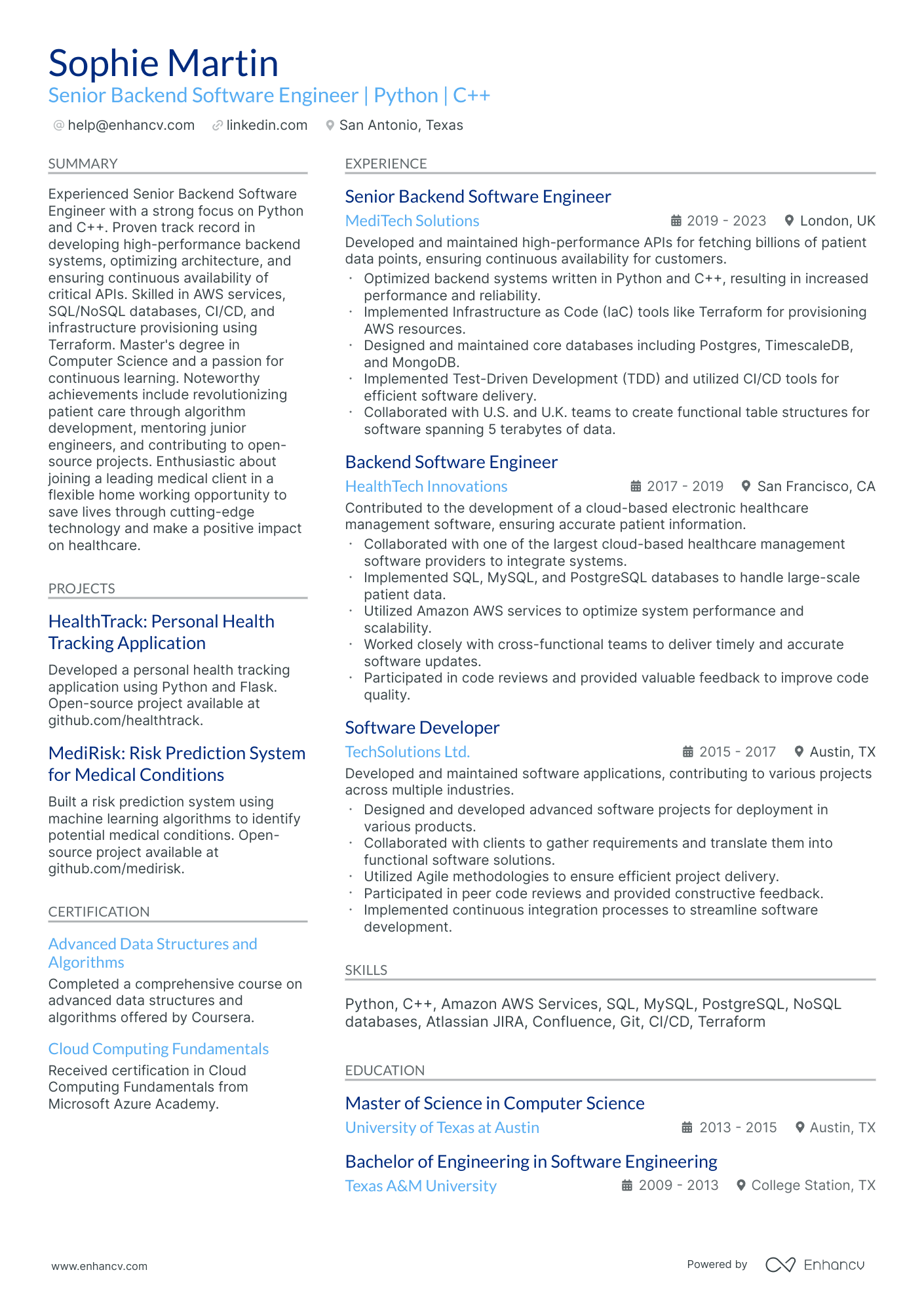One common challenge faced by backend engineers when crafting their resume is adequately showcasing their technical skills in a way that sets them apart from other experienced candidates. Our guide can assist with this issue by providing curated industry-specific advice on how to effectively highlight unique achievements, present complex projects, and tailor the skill section to clearly communicate one's proficiency in essential backend technologies.
Dive into this guide to learn how to craft a backend engineer resume that offers recruiters a clear view of your career journey:
- Draw from our backend engineer resume samples, highlighting top skills, certifications, and more.
- Illuminate the potential impact you can bring to an organization through your resume summary and experience.
- Spotlight your unique backend engineer expertise, emphasizing tangible results and standout achievements.
Recommended reads:
Formatting the layout of your backend engineer resume: design, length, and more
When it comes to the format of your backend engineer resume , you've plenty of opportunities to get creative. But, as a general rule of thumb, there are four simple steps you could integrate into your resume layout.
- If you have plenty of experience, you'd like to showcase, invest in the reverse-chronological resume format. This format focuses on your latest experience items and skills you've learned during your relevant (and recent) jobs.
- Don't go over the two-page limit, when creating your professional backend engineer resume. Curate within it mainly experience and skills that are relevant to the job.
- Make sure your backend engineer resume header includes all of your valid contact information. You could also opt to display your professional portfolio or LinkedIn profile.
- Submit or send out your backend engineer resume as a PDF, so you won't lose its layout and design.
Each market has its own resume standards – a Canadian resume layout may differ, for example.
Upload your resume
Drop your resume here or choose a file. PDF & DOCX only. Max 2MB file size.
Pro tip
While color can enhance your backend engineer resume by emphasizing key details like headlines, job titles, and degrees, moderation is key. Stick to a primary and a secondary color to maintain professionalism and avoid a cluttered appearance.
Essential sections for a standout backend engineer resume:
- The top section should combine your header—with accurate contact details—and a concise summary or objective that encapsulates your professional achievements.
- An experience section that chronicles your career trajectory and how each role contributed to your professional development.
- Highlight significant achievements that demonstrate the practical application of your skills, leading to tangible results.
- Include industry-recognized certifications to underscore your technical proficiency or interpersonal skills.
- Detail your educational background relevant to the field.
What recruiters want to see on your resume:
- Experience with relevant back-end languages and frameworks (e.g., Node.js, Python, Java, Ruby on Rails, .NET).
- Knowledge of relational and noSQL databases (e.g., MySQL, PostgreSQL, MongoDB).
- Understanding of cloud services and architecture (e.g., AWS, Google Cloud, Azure).
- Demonstrable experience in API design and development (REST, GraphQL).
- Proficiency in testing and debugging back-end applications, with knowledge of test-driven development (TDD) and continuous integration/continuous deployment (CI/CD) practices.
Recommended reads:
Writing your backend engineer resume experience
Here are some quick tips on how to curate your backend engineer professional experience:
- Always ensure that you quantify your achievements by implementing the Situation-Task-Action-Result framework;
- When writing each experience bullet, make sure you're using active voice;
- Stand out by including personal skills you've grown while at the job;
- Be specific about your professional experience - it's not enough to say you have great communication skills, but rather explain what your communication track record led to?
Wondering how other professionals in the industry are presenting their job-winning experience? Check out how these backend engineer professionals put some of these best practices into action:
- Developed scalable backend systems using Java and Spring framework, handling high volumes of user data.
- Implemented RESTful APIs for seamless integration with front-end systems resulting in improved application performance.
- Optimized database queries, reducing response time by 30% and improving overall system efficiency.
- Collaborated with cross-functional teams to design and implement new features, contributing to a 25% increase in user engagement.
- Led the migration of legacy codebase to a microservices architecture, enhancing system modularity and maintainability.
- Built RESTful APIs using Python and Django framework, supporting real-time data processing for a high-traffic application.
- Designed and implemented a caching mechanism that reduced API response time by 40%, resulting in a better user experience.
- Collaborated with front-end engineers to integrate third-party payment gateways, enabling seamless transactions.
- Performed code reviews and mentored junior developers, improving code quality and team productivity.
- Participated in agile development processes, delivering bi-weekly sprints and meeting project deadlines consistently.
- Developed scalable RESTful APIs using Node.js and Express, serving millions of requests per day.
- Implemented a message queue system using RabbitMQ, enabling asynchronous and fault-tolerant processing.
- Optimized database queries and introduced indexing techniques, reducing response time by 45%.
- Collaborated with the mobile development team to design and implement push notification services.
- Led the migration from a monolithic architecture to a microservices-based architecture, improving system reliability.
- Developed backend systems using PHP and MySQL, handling user authentication and data storage.
- Designed and implemented an automated email notification system resulting in a 20% increase in user engagement.
- Collaborated with front-end developers to integrate social media APIs, enabling seamless sharing of content.
- Maintained and optimized legacy codebase, fixing critical bugs and enhancing application performance.
- Implemented data backup and recovery solutions, ensuring data integrity and minimizing downtime.
- Developing scalable backend systems using Golang and Gin framework, handling high volumes of concurrent requests.
- Designing and implementing event-driven microservices architecture using Apache Kafka, ensuring scalability and fault tolerance.
- Integrating with third-party APIs for payment processing, resulting in a seamless and secure transaction flow.
- Optimizing database queries and utilizing Redis caching for improved system performance.
- Participating in code reviews and providing technical guidance to junior engineers in an Agile development environment.
- Developed RESTful APIs using Ruby on Rails, enabling efficient data exchange between front-end and back-end systems.
- Implemented background job processing using Sidekiq for handling resource-intensive tasks resulting in improved system responsiveness.
- Collaborated with DevOps team to deploy applications on AWS infrastructure, ensuring high availability and scalability.
- Conducted load testing and performance optimization, achieving a 50% improvement in response time.
- Participated in daily stand-ups and sprint planning meetings, delivering features within the defined timelines.
- Built scalable backend systems using Java and Play framework, handling millions of user requests per day.
- Implemented message queueing system using Apache Kafka for asynchronous and fault-tolerant processing.
- Optimized database queries with Hibernate ORM, resulting in a 35% reduction in response time.
- Collaborated with front-end developers to design and implement real-time chat and notifications functionality.
- Led the development of an analytics dashboard, providing valuable insights on user behavior and application usage.
- Developed RESTful APIs using Python and Flask framework, supporting seamless integration with multiple client applications.
- Designed and implemented a distributed caching mechanism using Memcached, improving application performance by 40%.
- Collaborated with the frontend team to implement real-time data synchronization using WebSocket protocol.
- Participated in code refactoring and architectural improvements resulting in a more modular and maintainable codebase.
- Implemented automated unit testing and continuous integration practices, ensuring code quality and reliability.
- Developed scalable backend systems using Python and Django framework, handling high volumes of user-generated content.
- Implemented asynchronous task processing using Celery, improving system responsiveness and scalability.
- Collaborated with the data science team to implement machine learning models for content recommendation.
- Optimized database queries by introducing indexing and denormalization techniques, resulting in a 30% reduction in response time.
- Led the development of an admin dashboard for managing user-generated content and analytics.
- Developed RESTful APIs using Node.js and Express framework, facilitating seamless communication between client and server.
- Implemented authentication and authorization mechanisms using OAuth 2.0, ensuring secure access to resources.
- Collaborated with the mobile development team to design and implement push notification services.
- Performed code reviews and mentored junior developers, enhancing overall code quality and team productivity.
- Worked closely with product managers to define requirements and deliver features within tight deadlines.
Quantifying impact on your resume
<ul>
Writing your backend engineer experience section without any real-world experience
Professionals, lacking experience, here's how to kick-start your backend engineer career:
- Substitute experience with relevant knowledge and skills, vital for the backend engineer role
- Highlight any relevant certifications and education - to showcase that you have the relevant technical training for the job
- Definitely include a professional portfolio of your work so far that could include university projects or ones you've done in your free time
- Have a big focus on your transferable skills to answer what further value you'd bring about as a candidate for the backend engineer job
- Include an objective to highlight how you see your professional growth, as part of the company
Recommended reads:
Pro tip
Remember, the experience section isn't just about traditional roles. It's a space to highlight all professional learning, whether from internships, contract roles, research projects, or other relevant experiences. If it's added value to your skill set for the backend engineer role, it deserves a mention.
Spotlighting your backend engineer hard and soft skills
Hard skills denote your technological proficiency and expertise in specific tools or software. These skills are often validated through certifications and hands-on experience.
Soft skills, on the other hand, reflect your interpersonal abilities and how you navigate workplace dynamics. These skills are cultivated over a lifetime and can be more nuanced.
Why the emphasis on both? Hard skills demonstrate your technical competence and reduce training needs. Soft skills suggest adaptability and cultural fit.
To optimize your skills section:
- Forego basic skills like "Excel" in favor of more specific proficiencies like "Excel Macros".
- Highlight core values and work ethics as soft skills, indicating what you prioritize in a professional setting.
- If relevant, create a distinct section for language proficiencies.
- Balance hard and soft skills by crafting a strengths or achievements section, illustrating outcomes achieved through both skill sets.
To assist you, we've curated a list of skills highly sought after by recruiters. Ensure you integrate those that resonate with your expertise and the prospective employer's needs:
Top skills for your backend engineer resume:
Python
Java
Node.js
Ruby on Rails
SQL
RESTful APIs
Docker
Kubernetes
MongoDB
Git
Problem-solving
Communication
Teamwork
Time management
Adaptability
Critical thinking
Attention to detail
Creativity
Collaboration
Self-motivation
Pro tip
If you're in the process of learning a pivotal skill for the role, mention this on your resume. It demonstrates initiative while maintaining transparency.
Detailing your education and top backend engineer certifications on your resume
Your education section can reflect a variety of skills and experiences relevant to the position.
- List post-secondary qualifications, noting the institution and duration.
- If you're currently studying, mention your expected graduation date.
- Exclude qualifications unrelated to the role or industry.
- If relevant, delve into your educational background, especially if it was research-intensive.
Including both relevant education and certifications on your backend engineer resume can set you apart. It not only showcases your qualifications but also your commitment to the profession.
When listing these on your backend engineer resume, make sure to:
- Highlight degrees and certificates relevant to the role.
- Mention the awarding institution for credibility.
- Include the start and end dates, or if the education/certification is ongoing.
- If relevant, incorporate a few keywords from the job advert within the description of the certification or degree.
If you have additional certifications not directly related to the role, consider placing them towards the end of your resume. This way, they can be viewed as personal interests rather than core qualifications.
For a quick update, check out our list of popular backend engineer certifications curated by the Enhancv team.
Best certifications to list on your resume
- Microsoft Certified: Azure Developer Associate (AZ-204) - Microsoft
- AWS Certified Developer – Associate (DVA-C01) - Amazon Web Services
- Google Cloud Certified - Professional Cloud Architect - Google Cloud
- Oracle Certified Master, Java EE Enterprise Architect (OCMJEA) - Oracle
- Red Hat Certified Engineer (RHCE) - Red Hat
- IBM Certified Database Administrator – DB2 - IBM
Please note that direct links to specific certifications may change over time due to website updates. If a link is not working, navigate to the main website and search for the certification from there.
Pro tip
List your degrees in reverse order, starting with the newest. A recent PhD or unique field could set you apart.
Recommended reads:
Deciding between a backend engineer resume summary or objective
While some argue the resume summary or objective is outdated, these sections can effectively:
- Integrate pivotal backend engineer keywords.
- Showcase your achievements.
- Clarify your motivation for applying.
The distinction lies in their focus:
- A resume objective emphasizes your career aspirations.
- A resume summary spotlights your career milestones.
Opt for a summary if you have a rich experience you wish to highlight immediately. Conversely, an objective can be ideal for those wanting to underscore their aspirations and soft skills.
For inspiration, we've curated samples from industry professionals to guide your resume summary or objective crafting:
Resume summary and objective examples for a backend engineer resume
Optimize your resume summary and objective for ATS
Drop your resume here or choose a file.
PDF & DOCX only. Max 2MB file size.
Enhancing your backend engineer resume with additional sections
Make your backend engineer resume truly distinctive by adding supplementary sections that showcase:
- Awards that underscore your industry recognition.
- Projects that bolster your application's relevance.
- Hobbies, if they can further your candidacy by revealing facets of your personality.
- Community involvement to highlight causes you champion.
Key takeaways
- The format and layout of your backend engineer resume should reflect your career experience;
- Use the resume summary and objective to highlight your most prominent accomplishments;
- Always be specific about your experience and consider what value each bullet adds to your backend engineer application;
- Consider how your academic background and technical capabilities could further showcase your alignment to the role;
- Your soft skills should contribute to your overall backend engineer profile - aligning your personality with your professional self.
